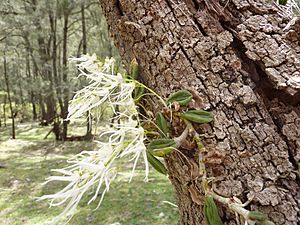Tongue orchid facts for kids
Quick facts for kids Tongue orchid |
|
|---|---|
 |
|
| Growing near the Chandler River | |
| Scientific classification | |
| Genus: |
Dendrobium
|
| Species: |
linguiforme
|
| Synonyms | |
|
|
The Tongue Orchid, also known as the thumbnail orchid or tick orchid, is a special kind of plant from the orchid family. You can only find it in eastern Australia, which means it is endemic there. This amazing orchid grows on trees or rocks. It has thin, trailing stems, thick leaves, and can produce up to twenty white or cream-colored flowers in early spring.
Contents
What Does the Tongue Orchid Look Like?
The Tongue Orchid is an epiphyte, meaning it grows on other plants (like trees) but doesn't harm them. It can also be a lithophyte, growing on rocks. Its stems lie flat and produce thin roots that are about 1 to 4 centimeters (0.4 to 1.6 inches) long and 3 to 4 millimeters (0.1 to 0.2 inches) thick.
Each branch of the stem has a single leaf. This leaf is shaped like an oblong or an egg, measuring 2 to 4 centimeters (0.8 to 1.6 inches) long and 8 to 15 millimeters (0.3 to 0.6 inches) wide. It's quite thick and juicy, about 4 to 6 millimeters (0.16 to 0.24 inches) thick. The top of the leaf is smooth but has interesting ridges and grooves.
Tongue Orchid Flowers
The Tongue Orchid can have up to twenty flowers arranged on a long stem called a raceme, which is 5 to 15 centimeters (2 to 6 inches) long. The main parts of the flower are the sepals and petals, which are white to cream-colored.
- The top sepal is thin and spear-shaped, 15 to 22 millimeters (0.6 to 0.9 inches) long.
- The side sepals are 18 to 22 millimeters (0.7 to 0.9 inches) long.
- The petals are a little smaller than the sepals.
The labellum (a special lip-like petal found on orchids) is cream-colored with light purple marks. It's about 5 to 6 millimeters (0.20 to 0.24 inches) long. These beautiful flowers bloom in September and October.
Where Does the Tongue Orchid Grow?
The Tongue Orchid lives in New South Wales and Queensland in Australia. It likes to grow on rocks and trees, often in sclerophyll forests (which have tough-leaved plants) or sometimes in rainforests or rocky areas.
In New South Wales, you can find it along the coast and on the tablelands north of Ulladulla. It also grows inland near Gungal and Tamworth. In Queensland, it's found from the Atherton Tableland all the way south to Townsville and from Gympie down to the New South Wales border.
Images for kids
-
Growing near West Head in Ku-ring-gai Chase N.P.
-
Growing in the Oxley Wild Rivers N.P.






